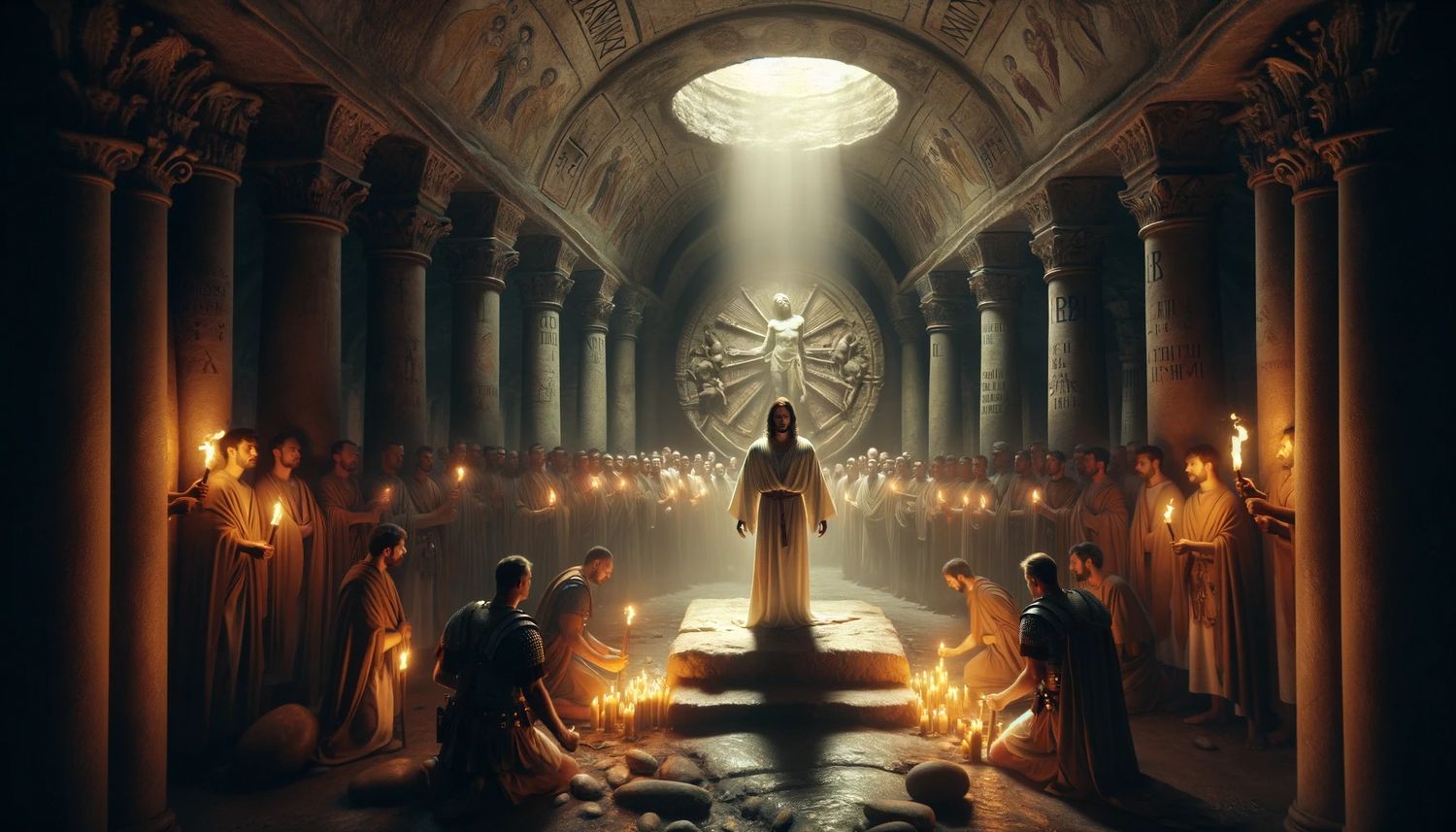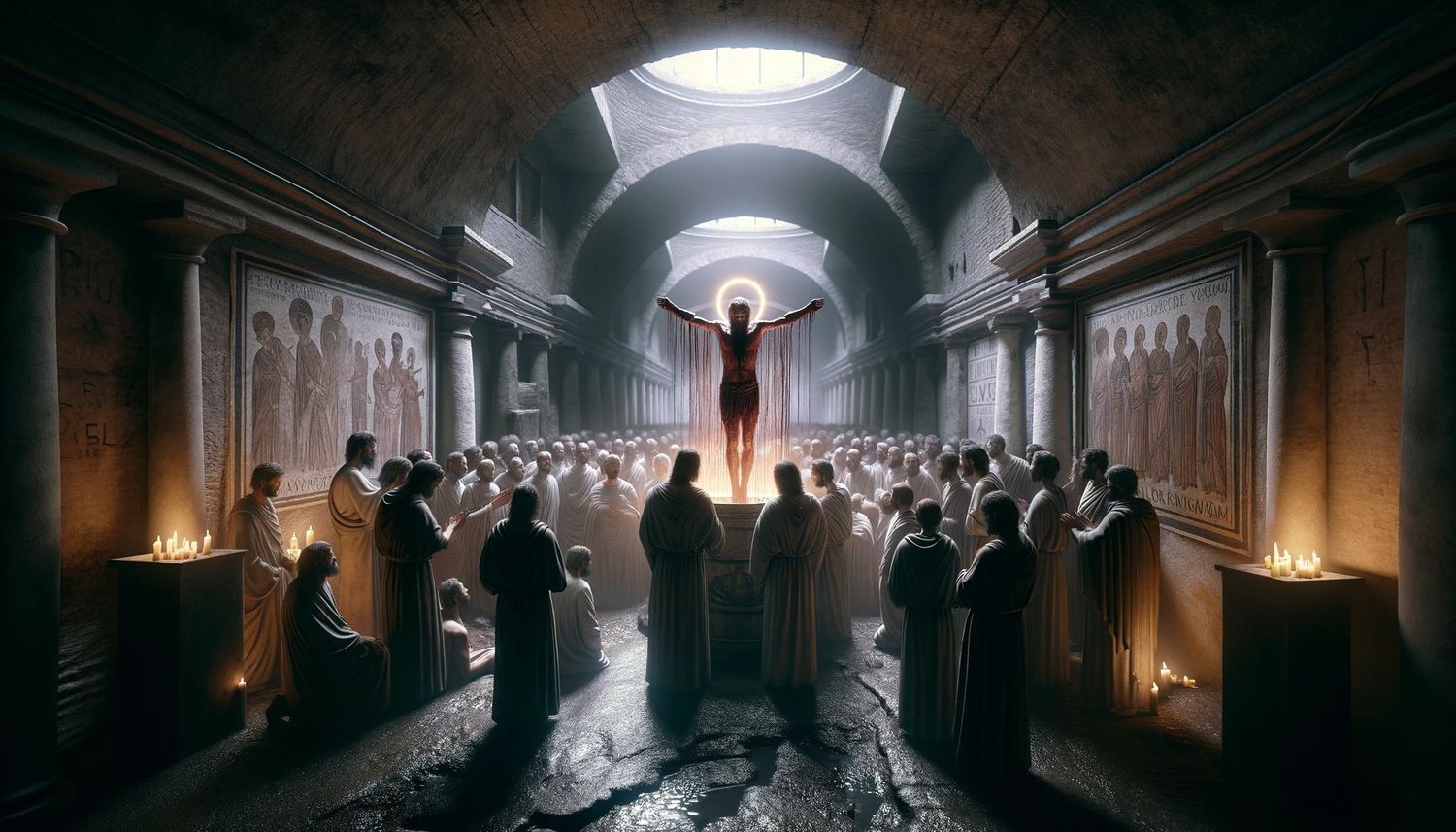Home>Theology and Spirituality>What Is Mormon Baptism


Theology and Spirituality
What Is Mormon Baptism
Published: February 26, 2024
Peter Smith, Editorial Director at Christian.net, combines deep insights into faith, politics, and culture to lead content creation that resonates widely. Awarded for his contributions to religious discourse, he previously headed a major organization for religious communicators, enhancing dialogue on faith's societal impacts.
Learn about the significance and process of Mormon baptism in theology and spirituality. Explore the beliefs and practices of this sacred ritual.
(Many of the links in this article redirect to a specific reviewed product. Your purchase of these products through affiliate links helps to generate commission for Christian.net, at no extra cost. Learn more)
Table of Contents
Introduction
What is Mormon baptism? Mormon baptism is a sacred and essential ordinance in the Church of Jesus Christ of Latter-day Saints (LDS Church). It is a symbolic ritual that signifies a person's commitment to follow Jesus Christ and his teachings. Mormon baptism is a significant event in the life of a member of the LDS Church, and it is believed to be a necessary step for salvation in the afterlife. In this article, we will explore the history, beliefs, practices, and significance of Mormon baptism in the context of the LDS Church.
Read more: What Is A Mormon Baptism Like
The History of Mormon Baptism
-
Origins of Mormon Baptism: Mormon baptism has its roots in the early history of the Church of Jesus Christ of Latter-day Saints. The founder of the LDS Church, Joseph Smith, received a revelation in 1829, instructing him on the proper method of baptism. This revelation, found in the Doctrine and Covenants, outlines the essential elements of baptism, including the mode of immersion and the authority to perform the ordinance.
-
Restoration of Priesthood Authority: According to Mormon belief, the authority to baptize was restored to Joseph Smith and Oliver Cowdery by heavenly messengers, namely John the Baptist, who appeared to them as resurrected beings. This event, known as the restoration of the Aaronic Priesthood, is considered a pivotal moment in the history of Mormon baptism, as it established the proper authority to perform the ordinance.
-
Early Practices of Mormon Baptism: In the early days of the LDS Church, baptism was conducted in rivers, streams, or other bodies of water, following the pattern of the baptism of Jesus Christ by John the Baptist in the New Testament. As the Church grew, baptismal fonts were constructed in LDS temples and meetinghouses to accommodate the increasing number of baptisms.
-
Continuation of the Ordinance: Over the years, Mormon baptism has continued to be an integral part of the religious life of Latter-day Saints. The Church has established specific guidelines and procedures for baptism, ensuring that it remains a sacred and meaningful rite for individuals entering the faith.
-
Global Reach of Mormon Baptism: Today, Mormon baptism is practiced by millions of members worldwide, reflecting the global expansion of the LDS Church. The history of Mormon baptism is a testament to the enduring significance of this ordinance in the religious tradition of the Latter-day Saints.
The Beliefs and Practices of Mormon Baptism
-
Sacred Covenant: Mormon baptism is viewed as a sacred covenant between an individual and God. It is a voluntary decision made by those who have reached the age of accountability, typically eight years old in the LDS Church. The act of baptism symbolizes a commitment to follow the teachings of Jesus Christ and to live according to the principles of the gospel.
-
Remission of Sins: Mormons believe that baptism is essential for the remission of sins. Through baptism by immersion, individuals are cleansed from their past transgressions and are considered spiritually reborn. This act of purification is seen as a necessary step towards spiritual renewal and a fresh start in the individual's journey of faith.
-
Authority and Ordinance: Central to Mormon belief is the concept of priesthood authority. Baptism must be performed by someone who holds the priesthood authority recognized by the LDS Church. This ensures that the ordinance is conducted in accordance with the divine will of God and is considered valid within the Mormon faith.
-
Gift of the Holy Ghost: Following baptism, individuals receive the laying on of hands for the gift of the Holy Ghost. This is believed to bestow spiritual guidance, comfort, and inspiration from the Holy Spirit. The gift of the Holy Ghost is seen as a companion and source of strength as individuals strive to live a righteous life.
-
Symbolism of Immersion: The method of baptism by immersion is significant in Mormon theology. It symbolizes the death, burial, and resurrection of Jesus Christ and represents a commitment to follow His example. Immersion in water is seen as a symbolic act of being buried with Christ and rising to a new life of discipleship.
-
Preparation and Commitment: Prior to baptism, individuals undergo a period of preparation, which may include instruction in the principles of the gospel and an understanding of the covenants associated with baptism. This preparation is intended to ensure that individuals are fully committed to living according to the teachings of Jesus Christ.
-
Family and Community Involvement: Mormon baptism is often a communal event, with family members, friends, and fellow church members participating in the ordinance. The support and encouragement of the community play a significant role in the baptismal process, reinforcing the individual's sense of belonging and commitment to the LDS Church.
-
Continued Growth and Development: Baptism is considered the beginning of a lifelong journey of discipleship and spiritual growth. It marks the entry into the Church and the commencement of a life dedicated to following the teachings of Jesus Christ. The ongoing development of faith, service, and adherence to gospel principles is emphasized as individuals progress in their spiritual journey.
In summary, the beliefs and practices of Mormon baptism reflect the foundational principles of faith, repentance, and commitment to the teachings of Jesus Christ within the LDS Church.
The Role of Baptism in the Mormon Church
-
Initiation into the Church: Baptism plays a central role in initiating individuals into the Mormon Church. It is the first ordinance in a series of essential steps outlined in LDS doctrine, known as the "first principles and ordinances of the Gospel." Baptism marks the formal entry into the community of Latter-day Saints and signifies a commitment to embrace the teachings and principles of the Church.
-
Membership and Identity: For Mormons, baptism is a defining moment that establishes one's membership in the Church. It signifies a public declaration of faith and allegiance to the beliefs and practices of the LDS Church. Through baptism, individuals become part of a community of believers who share common values, goals, and a collective identity as followers of Jesus Christ.
-
Spiritual Rebirth and Renewal: In Mormon theology, baptism is regarded as a transformative experience that symbolizes spiritual rebirth and renewal. It represents a cleansing of past sins and a commitment to live a life of righteousness. The act of immersion in water is seen as a symbolic burial of the old self and a rising to a new life dedicated to following the example of Jesus Christ.
-
Preparation for Further Ordinances: Baptism is a prerequisite for receiving other essential ordinances in the LDS Church, such as confirmation and the bestowal of the gift of the Holy Ghost. These ordinances are considered integral to the spiritual progression and development of individuals within the Mormon faith. Baptism sets the stage for individuals to receive additional blessings and spiritual guidance as they continue their journey of discipleship.
-
Foundation for Eternal Progression: According to Mormon belief, baptism is a foundational step in the process of eternal progression. It is seen as a necessary requirement for salvation and exaltation in the afterlife. Through baptism and subsequent faithful adherence to gospel principles, Mormons believe they can qualify for the blessings and promises associated with eternal life in the presence of God.
-
Commitment to Service and Mission: Baptism in the Mormon Church signifies a commitment to service and mission. It is a pledge to actively participate in the work of the Church, including missionary efforts, service to others, and the promotion of gospel values. Baptized members are encouraged to share their faith and contribute to the growth and welfare of the Church and its members.
-
Symbol of Unity and Fellowship: Baptism fosters a sense of unity and fellowship among members of the LDS Church. It symbolizes a shared commitment to the teachings of Jesus Christ and the principles of the gospel. Through baptism, individuals become part of a global community of believers, united in their faith and dedication to living according to the precepts of the Mormon Church.
In essence, the role of baptism in the Mormon Church is multifaceted, encompassing aspects of initiation, identity, spiritual transformation, progression, commitment, and unity within the community of Latter-day Saints.
The Process of Mormon Baptism
-
Preparation and Instruction: Before undergoing baptism, individuals, typically at the age of eight or older, receive instruction in the principles of the gospel and the significance of the baptismal covenant. This preparation may involve discussions with parents, family members, and church leaders to ensure a clear understanding of the commitments associated with baptism.
-
Decision and Consent: Upon reaching the age of accountability, individuals are given the opportunity to decide whether they are ready to be baptized. This decision is based on their understanding of the teachings of Jesus Christ, repentance, and the desire to follow His example. The consent of the individual is a crucial aspect of the baptismal process, emphasizing the voluntary nature of the covenant.
-
Selection of a Baptismal Date: Once an individual expresses their readiness for baptism, a specific date is chosen for the ordinance. This date is often a significant and memorable occasion for the individual and their family, marking the beginning of their formal membership in the LDS Church.
-
Baptismal Service: The actual baptismal service takes place in a font located in an LDS meetinghouse or temple. The individual being baptized, accompanied by a priesthood holder, enters the baptismal font. The officiator, typically a male member of the priesthood, pronounces a prayer and then immerses the individual completely in the water, symbolizing the burial of the old self and the beginning of a new life as a disciple of Jesus Christ.
-
Confirmation and Gift of the Holy Ghost: Following the baptism, the individual is confirmed a member of the Church and receives the laying on of hands for the gift of the Holy Ghost. This ordinance is performed by the laying on of hands by those holding the Melchizedek Priesthood, and it is believed to bestow the constant companionship of the Holy Ghost, providing guidance, comfort, and spiritual strength.
-
Celebration and Support: Baptism is often celebrated with family, friends, and fellow church members, who offer support, encouragement, and congratulations to the newly baptized individual. This communal aspect of the baptismal process reinforces the sense of belonging and unity within the LDS community.
-
Continued Guidance and Nurturing: Following baptism, individuals receive ongoing support and guidance from family, church leaders, and fellow members as they strive to live according to the principles of the gospel. This nurturing environment is intended to help individuals maintain their commitment to the baptismal covenant and continue their spiritual growth within the LDS Church.
In summary, the process of Mormon baptism involves careful preparation, personal decision-making, the actual ordinance of baptism by immersion, confirmation, and ongoing support as individuals embark on their journey of discipleship within the Church of Jesus Christ of Latter-day Saints.
Read more: What Is Mormon Baptism Of The Dead
The Significance of Mormon Baptism in the Afterlife
-
Salvation and Exaltation: In Mormon theology, baptism is intricately linked to the concept of salvation and exaltation in the afterlife. It is believed that through baptism and faithful adherence to the principles of the gospel, individuals can qualify for the blessings of eternal life in the presence of God. Baptism is seen as the initial step in the process of spiritual progression that ultimately leads to exaltation and the fulfillment of divine promises.
-
Access to Higher Blessings: Mormons believe that baptism is a prerequisite for receiving other essential ordinances and blessings, such as temple ordinances, marriage, and the sealing of families for eternity. These ordinances are considered integral to the eternal progression and unity of families in the afterlife. Baptism opens the door to these higher blessings and opportunities for eternal growth and development.
-
Cleansing and Renewal: Baptism is viewed as a cleansing ordinance that washes away past sins and transgressions. In the context of the afterlife, this spiritual purification is believed to prepare individuals to stand spotless before God at the time of judgment. The act of baptism symbolizes a commitment to live a life of righteousness and obedience to God's commandments, which is essential for the ultimate reward of eternal life.
-
Inclusion in God's Kingdom: Mormons believe that baptism is a necessary requirement for entering the kingdom of God in the afterlife. It is through baptism and the subsequent faithful adherence to gospel principles that individuals become eligible for the blessings and privileges associated with the celestial kingdom, the highest degree of glory in Mormon theology. Baptism is thus seen as a pivotal step in securing a place in God's kingdom.
-
Continued Spiritual Progression: Beyond the immediate effects of baptism, Mormons believe that the ordinance sets the stage for continued spiritual progression in the afterlife. It is seen as the foundation upon which individuals can build a life of discipleship, service, and adherence to the teachings of Jesus Christ. Baptism is considered a catalyst for ongoing growth and development in the eternities.
-
Family Unity and Eternal Relationships: In Mormon belief, baptism is intricately connected to the concept of eternal families. Through baptism and subsequent ordinances, individuals can be sealed to their families for time and all eternity. This sealing ordinance ensures that family relationships can endure beyond mortality and into the eternities, fostering a sense of unity, love, and continuity in the afterlife.
-
Opportunity for Redemption: Baptism is viewed as an opportunity for individuals to enter into a covenant relationship with God, which provides the framework for repentance, forgiveness, and eventual redemption. In the afterlife, the effects of baptism are believed to extend to those who did not have the opportunity to be baptized during their mortal lives, offering them the chance to accept the ordinance and its associated blessings.
In summary, the significance of Mormon baptism in the afterlife encompasses the attainment of salvation, access to higher blessings, spiritual cleansing, inclusion in God's kingdom, continued progression, family unity, and the opportunity for redemption beyond mortality. It is a foundational step in the eternal journey of individuals within the framework of Mormon theology.














